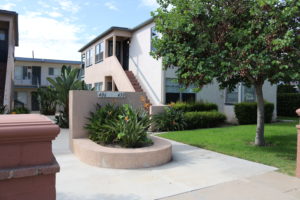
The village atmosphere that Coronadans cherish comes at a price. Home prices and rents that are out of reach for average people. Studio rents start at around $1,300 per month and one-bedrooms go for $1,500 plus, according to the rental hot sheet and realtor Mike Napolitano. “Condos start at $650,000 and houses at $1.1 million,” he said. It’s a sellers’ market at costs to a community that go beyond dollars and cents.
“Housing is the most essential part of being a human being. It’s a key determinate of your wellbeing. It matters to economy, [and] businesses’ ability to attract and keep employees,” Councilman Whitney Benzian said. “Being a Coronado police officer might be a great career, but when you have to drive 45, 50 minutes every day to work, and an hour and a half in total, that’s not desirable. You’re going to go to Escondido, a more affordable city.”
Benzian is not alone in realizing the importance of affordable housing. Last year the state legislature addressed the issue with SB 1069 by making it easier for people to rent out granny flats, or accessory dwelling units (ADUs), as a way to create more housing. How much of an impact these will have is questionable.
You’re not going to see tons of people putting these in. I don’t think it’s going to be a huge problem, most people don’t have backyards large enough, Benzian said. “This is a fairly affluent town, and lots of people won’t need the extra income. I don’t know if it’s going to solve the problem, maybe it helps.”
Even if every homeowner was willing to give up their backyard for a tenant, it wouldn’t make a dent in an impossibly tight rental market. Under the state law ADUs can only be added to single family units. Under a proposed city building code, the units can’t be larger than 800 square feet. This is the size the city’s planning commission approved at its July meeting. The council will vote on the commission’s recommendation at its September 19 meeting.

Coronado has 3,618 single family units, according to the San Diego Association of Governments (SANDAG). So far only a couple of residents have submitted plans for an ADU, according to City Planner Jesse Brown.
Even if homeowners build an ADU, it would not significantly bring rents down. “As rentals, they may be less expensive than a studio at the Shores, but unlikely to be affordable,” said Rachael Hurst, the city’s director of community development. “Why would an owner of an ADU rent it below market?”
Rents and home prices are market driven. There are a number of factors that keep prices high. The biggest one is desirability. “People from all over the world want to buy a house here,” said Hurst. Even if only for a few months out of the year. The secondary home market has been growing for over a decade. A couple of years ago the number of part-time home owners eclipsed year-round residents. Secondary home buyers “drive up the housing prices, without a doubt,” Benzian said. Many come flush with cash and deep pockets. “The average middle income family, who has to save for a down payment and secure a loan, can’t compete.”
Similar forces affect the rental market. For decades Coronado has had less than 1% rental vacancy, making it almost as tough to rent as it is to buy here.
For renters there are some affordable apartments, but only a select number of people can live in one. You have to be at or near the poverty level to qualify. All have long waiting lists, Hurst points out. Like other housing options here, the supply is limited. All were built with funds from the city’s redevelopment agency, Hurst pointed out. Twenty percent of the tax increment to build affordable housing. When redevelopment was abolished five years ago, money for low-cost rentals went away as well.
The only funding source left, according to Hurst, is a subdivision ordinance that requires contractors to reserve 20% of building for affordable housing, also known as Section H housing. Because Coronado subdivisions are small, no more than six units, you might get an additional unit for every five you build. Contractors can get out of the requirement by paying a $7,000 fee instead.
“Every subdivider pays the fee,” Hurst said. At some point the accumulated fees could be used to build affordable units, but it would take a long time. “It costs millions to build even modest apartments,” Hurst said.
More money may be coming in the future. There is a package of bills that will attempt to generate funds for affordable housing through various fees, taxes and bonds. The state legislature will vote on the package this fall. This week the County of San Diego approved a $25 million fund for affordable housing. Skeptics question whether these measures will have much of an impact. Read more here: State Legislature Takes Action to Address California’s Housing Crisis.
Adding more housing won’t necessarily drive down costs. You can build and build and still not meet needs of the people who want to live here will come and pay whatever it takes to own a home here. “This is a beautiful, desirable place, who wouldn’t want to live here?” Hurst asked.




